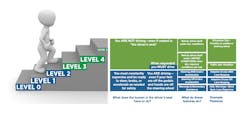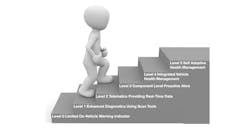All the talk about advanced driver assistance systems (ADAS), autonomous driving systems (ADS), and platooning vehicles keeps me focused on the road ahead. Yet, it’s also distracting as we move toward more electric vehicles, whether powered by batteries, fuel cells, or stored hydrogen.
At times, as I talk with people about the safety requirements of ISO26262 and consider the fiasco of the development and approval of the Boeing 737 MAX, it gets downright scary.
We are now allowing trucks with no mirrors. An electric vehicle has no exhaust. An autonomous vehicle may have no pedals, steering wheel, instrumentation, wipers, or a driver. Now that is a scary proposition, if not done carefully over time.
I started working on automating the truck to simplify the driver workload in 1985 when I began teaching software development at Eaton for automated mechanical transmissions. It took 30 years before AMTs were delivered in more than 50% of new vehicles. It will be more decades before all trucks on the road have AMTs, if ever.
Much of the world has now accepted the SAE definitions of 0-5 for levels of automation. This is important for trucking, in particular, as we need to move more freight every day with a diminishing number of available drivers. E-commerce requires many more local drivers, providing opportunities that don’t require being on the road for long periods of time. The drivers of the future will become more knowledgeable and higher paid. They will be expected to do more. They will be pilots of advanced automation rather than truck drivers.
There is a related chart putting the levels of diagnosis and repair for these different levels of automation into context. Technology is an enabler of many things, but, alas, it does not always work as intended. How many times do you have to reboot some piece of electronics by restarting it or, worse, unplugging it and plugging it back in. Transportation systems are designed to a higher level of reliability, but “things” still happen. These systems are more complex and will require more than a tire iron to fix. Technicians will become automated vehicle doctors.
Here are the SAE charts in a revised format that shows the steps going up to higher levels of automation and service diagnostics.
Here’s an idea of how we can move from Level 0 to Level 4 with assurance for safety and reliability.
- Step 1 provides safety features, but the driver is ALWAYS in control and responsible for the vehicle.
- Step 2 provides for the vehicle to take control in very limited conditions, with the driver always responsible for the vehicle. This is where we are today with what everyone refers to as SAE Level 2 vehicles. There is no “one size fits all” SAE Level 2 vehicle. Lack of standardization could be an issue.
- Step 3 is not so obvious. We can double or triple the productivity of a driver by having a single vehicle with a trailer, double trailers, or triple trailers. Many tankers are a straight truck with a trailer. Europe has had straight trucks with a trailer for decades, even though the tractor configuration has gained popularity in the last couple of decades.
- If we apply all the safety features of Step 2 to a longer combination vehicle, we will improve productivity, solve some of the driver shortage problem, and still have a very satisfying connection between the vehicles/trailers.
- Step 4 is a combination of today’s platooning capability with an older research idea for a following vehicle to follow a leading vehicle with something as simple as a special image on the back of the leading vehicle’s trailer. Compared to today’s platooning, it keeps the driver in the following vehicle.
- Having learned much about control in Step 3, the platoon can be nearly as tight as a physical connection in a long combination vehicle. This eliminates the concern in platooning of having a vehicle cut in.
- Step 5 now allows us to remove the driver in the following vehicle based on data and reliability and safety analysis of the results of step 4.
- Step 6 takes, literally, the next step. Having proven that a vehicle can follow another vehicle, it takes the much bigger step of having a vehicle follow the road, a much harder proposition than following another vehicle closely.
Just some thoughts to consider, or in some cases, reconsider from attempts to improve the safety and productivity of moving freight.
Let’s work up to the next level step-by-step.






